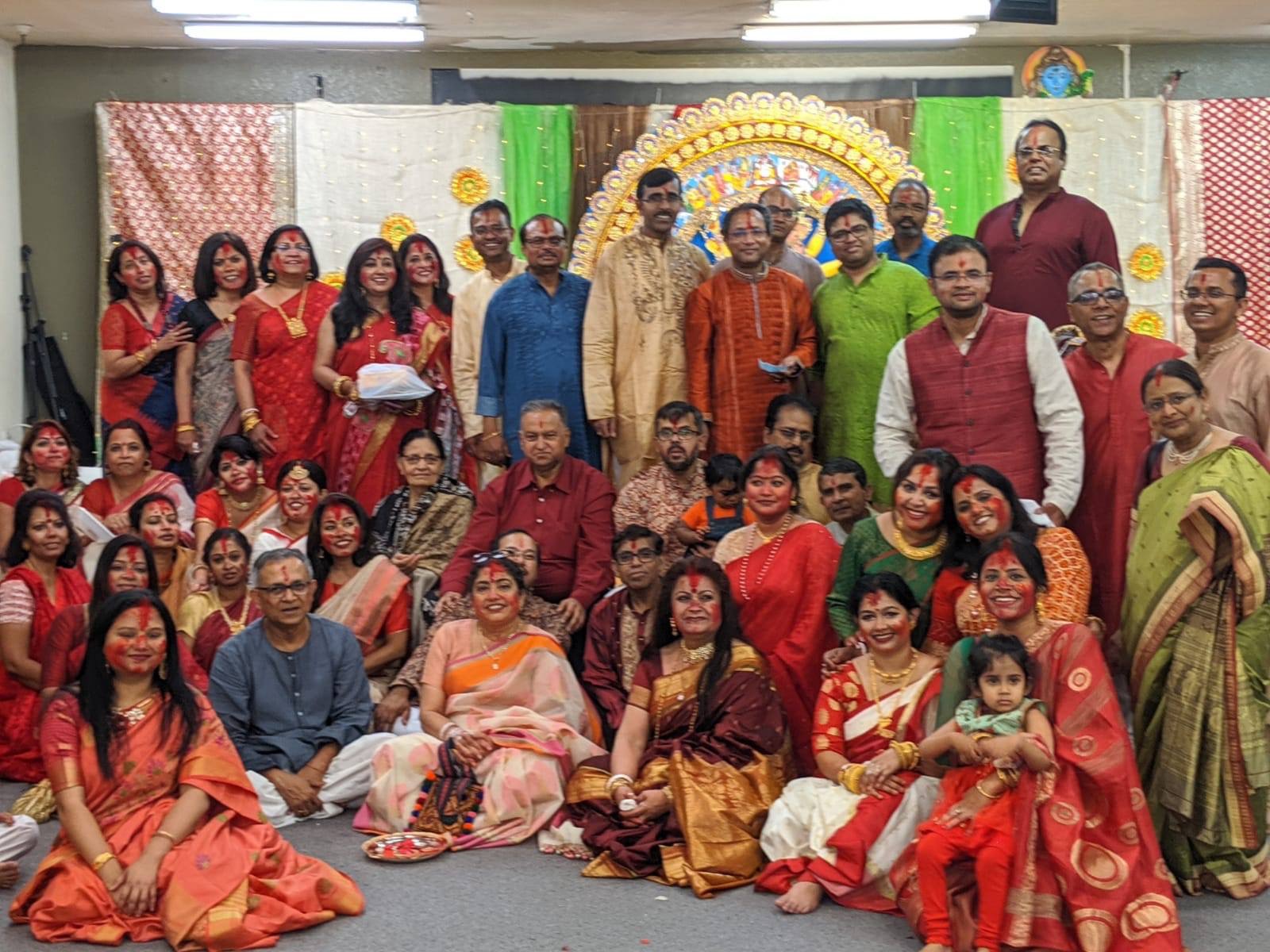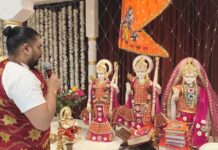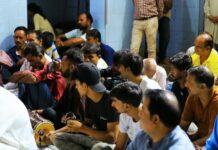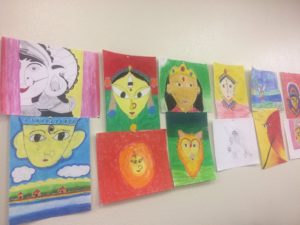
LAKSHMI IYER
India Post News Service
It is not often that one gets to hear a different perspective, connecting the ancient Hindu culture of worshipping the Divine Goddess with other long-lost civilizations’ goddesses.
With priest Jayanta Panda leading the worship at Fremont Hindu Temple Durga Puja, such an intellectual approach was to be expected.
Panda is a scientist at NASA. He got drawn to Hindu scriptures and philosophy many years ago as he was seeking to fill a void as a minority immigrant to the United States, and pass on the spiritual legacy of his motherland to his children raised in America.
He studied Sanskrit. For every Durga Puja, he displays the translation of the Sanskrit ‘shlokas’ (invocations) of the Goddess in English.
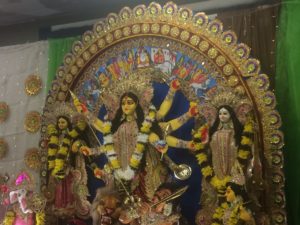
This time, he took everyone on a journey of worship of the Divine Feminine in all her forms to ancient Europe and the Middle East. For the start of the Durga Puja festivities on Mahalaya (the first day of Navaratri) September 29, he put together a presentation that talked about Goddess Durga’s forgotten sisters from Inana to Diana.
The Fremont Temple Durga Puja was conducted with usual traditional fervor, bringing Bengal to the Bay Area. From October 4 to 8 – Shashti (sixth day) to Bijoya (the tenth day also known as Vijayadasami and Dassera) – various ceremonies such as Sandhi Puja on Ashtami (the eighth day, the lighting of 108 lamps to signify the killing of the evil demon Mahishasura by Goddess Durga, Kumari Puja, the veneration of young girls as forms of the Goddess, and cultural programs marked the occasion.
The last day had Sindoor Khela. This is a ritual of married women smearing each other with ‘sindoor’ or vermillion.
Indian expats came dressed in their traditional finery with their families and participated in the rituals and feasts at the temple.

India Post caught up with Jayanta Panda on one of the days of Durga Puja to learn more about the links among ancient Goddesses of different cultures.
India Post (IP): What was special about this year’s Durga Puja?
Jayanta Panda (JP): We started with Mahalaya. So Mahalaya is the junction of ‘pitru paksha’ (phase of ancestors) and ‘Devi paksha’ (phase of the Goddess). So in ‘pitru paksha’ program, instead of calling our ‘shraddha’…our ancestors, I had a special presentation and it was Diana to Inana – the forgotten relatives of Devi Durga.
So it turns out that all over the ancient era…because Indus Valley, Mesopotamian and Egyptian civilizations are contemporary. Then it turns out that both in Mesopotamian and Egyptian civilizations, the people who used to follow them, they have converted back in various other monotheistic religions while us, Hindus have kept our civilization.
So if you go back there, to the Mesopotamian deities and the Egyptian deities, and then also to the European deities before they converted to Christianity, there are stark similarities.
So I had a presentation, I went from … you know this ‘pratima’ (image) came from Bengal, I went to Ellora Caves, and in the Ellora Caves, there is this Durga ‘murti’, which was created in 500 AD. You know, that worship was continued to 1300 AD. And then it was stopped and the Durga was defaced because of the conversions and the Islamic invasion. So that was the proof that Durga Puja has been going on for at least 1700 years.
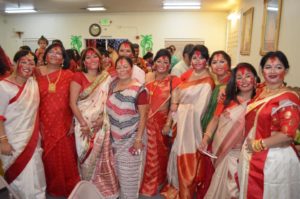
And then, I went to Pakistan and Pakistan Hinglaj Devi. Hinglaj Devi ‘Shakti Peetha’ is one of the forms of Durga Devi. But the interesting clue is that Hinglaj Devi ‘murti’ (idol) is still worshipped in a large number by the Muslim population. And they have a name for it. It is called Nana Devi.
And then, I went to Afghanistan. And in Afghanistan, there are these various… we went to Kushan empire. That was around 10 BC. There are various coins (pertaining to that period) and in that, there is a clear indication of ‘Singhavahini’ (one whose vehicle is a lion – Goddess Durga is depicted seated on a lion) – Singhavahini Devi with warrior woman depicted.
And then, I went to Afghanistan – a recent excavation – the Taliban kind of dug it out while digging a trench and the reading there goes that the Kushan emperor is put on the throne by the blessings of Nana Devi, and Nana is a distortion of Inana.
And then, we went to Sumerian, Akkadian and Babylonian deities, and their primary ‘Mata’ (Mother) was called Inana. And if you take the various seals that came out of it, it is exactly the same – warrior deities standing on lions. And they are also the ones bringing victory in war and there are various other descriptions.
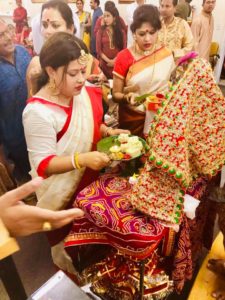
And then, we moved to Egypt. And in Egypt, there is Anak. Anak is also a warrior deity – she is a young woman who stands on the battlefield and gets the heads of the fallen soldiers and put them as a garland, and takes their hands and makes them as a sash around the waist just like Kali Mata.
All of them used to be worshipped. But, none of them is there. And then, we moved to Turkey. In Turkey, the similar deity is Artemis. Artemis was also a mother deity. She was worshipped in Turkey and Greece. In Greece, she was the warrior deity. In Turkey and other places, she was the mother deity who was the one who brings forth everyone into life. She has hundreds of breasts and all the animals.
And then, we went to the Vatican. As Christianity spread, there are quotes from various empires, especially in Armenia, about how Christianization destroyed them and brought every other temple to Christian sensibility. We showed all those temples (in the presentation) and what are the monuments remaining there.
From there, we moved to Athena. Athena is the deity of Athens, the protectress of the city of Athens. Again, she is standing there with a war sword and everything else.
And then, we moved to Diana, which is in Southern France, Italy and Spain. They are lost deities and they have a stark similarity to another hunting Goddess.
And that ends it. We said (in our presentation) that ends the ‘pitru paksha’ because those are the old, ancient Goddesses, and we started the Devi paksha with the one who is still alive – Devi Durga.
(This interview has been edited and paraphrased for reading format.)

